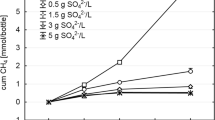Summary
Improved techniques are needed to predict potential methane generation from refuse buried in landfills. The Biochemical Methane Potential (BMP) test was used to measure the methane potential of ten refuse samples excavated from a Berkeley, CA, landfill. The test was conducted in 125-ml serum bottles containing phosphate-buffered medium and inoculated with anaerobically digested sewage sludge. Comparison of the measured BMP to the theoretical BMP calculated from measured cellulose and hemicellulose concentrations indicated that cellulose plus hemicellulose is not well correlated with the measured BMP. The average of the measured to theoretical BMP was 19.1% (range 0–53%, s.d.=16.9%). Measured sulfate concentrations showed that sulfate was an insignificant electron sink in the samples tested. Once methane production from the refuse was complete, 0.072 g of Whatman no. 1 filter paper was added to two of the four serum bottles incubated for each sample. An average of 84.9% (s.d=2.5%) of the added filter paper was recovered as methane, suggesting that some cellulose and hemicellulose present in refuse is recalcitrant or otherwise not bioavailable.
Similar content being viewed by others
References
Allison, D.W. and D.F. Osbourn. 1970. The cellulose-lignin complex in forages and its relationship to forage nutritive value. J. Agric. Sci., Camb. 74: 23–36.
Barlaz, M.A., R.K. Ham and D.M. Schaefer. 1989. Mass balance analysis of decomposed refuse in laboratory scale lysimeters. J. Environ. Eng. ASCE 115: 1088–1102.
Barlaz, M.A., D.M. Schaefer and R.K. Ham. 1989. Bacterial population development and chemical characteristics of refuse decomposition in a simulated sanitary landfill. Appl. Environ. Microbiol. 55: 55–65.
Barton, F.E. and D.E. Akin. 1977. Digestibility of delignified forage cell walls. J. Agric. Food Chem. 25: 1299–1303.
Bogner, J.E. 1990. Controlled study of landfill biodegradation rates using modified BMP assays. Waste Manag. Res. 8: 329–352.
Bookter, T.J., and R.K. Ham. 1982: Stabilization of solid waste in landfills. J. Environ. Eng. Div. ASCE 108: 1089–1100.
Buswell, A.M. and M.F. Mueller. 1952. Mechanisms of methane fermentation. Ind. Eng. Chem. 44: 550–552.
Colberg, P.J. 1988. Anaerobic microbial degradation of cellulose, lignin, oligolignols and monaromatic lignin derivatives. In: Biology of Anaerobic Microorganisms (Zehnder, A.J.B., ed.), pp. 333–372. Wiley-Liss. New York.
Dehority, B.A. and R.R. Johnson. 1961. Effect of particle size upon the in vitro cellulose digestibility of forages by rumen bacteria. J. Dairy Sci. 44: 2242–2249.
Effland, M.J. 1977: Modified procedure to determine acid soluble lignin in wood and pulp. TAPPI 60: 143–144.
Gurijala, K.R. and J.M. Suflita. 1993. Environmental factors influencing methanogenesis from refuse in landfills. Environ. Sci. Technol. 27: 1176–81.
Jung, H.G. and K.P. Vogel. 1986. Influence of lignin in digestibility of forage cell wall material. J. Anim. Sci. 62: 1703–1712.
Kenealy, W. and J.G. Zeikus. 1981. Influence of corrinoid antagonists on methanogen metabolism. J. Bacteriol. 146: 133–140.
Khan, A.W. 1977. Anaerobic degradation of cellulose by mixed culture. Can. J. Microbiol. 23: 1700–1705.
Owens, J.F. and D.P. Chynoweth. 1993. Biochemical methane potential of MSW components. Water Sci. Technol. 27: 1–14.
Owen, W.F., D.C. Stuckey, J.B. Healy, L.Y. Young and P.L. McCarty, 1979. Bioassay for monitoring biochemical methane potential and anaerobic toxicity. Water Res. 13: 485–492.
Peer, R.L., S.A. Thorneloe and D.L. Epperson. 1993. A comparison of methods for estimating global methane emissions from landfills. Chemosphere 26: 387–400.
Pettersen, R.C. and V.H. Schwandt. 1991. Wood sugar analysis by anion chromatography. J. Wood Chem. Technol. 11: 495–501.
Pfeffer, J.T. and K.A. Khan. 1976. Microbial production of methane from municipal refuse. Biotechnol. Bioeng. 18: 1179–1191.
Robinson, J.A. and J.M. Tiedje. 1984. Competition between sulfate reducing and methanogenic bacteria for H2 under resting and growing conditions. Arch. Microbiol. 137: 26–32.
Shelton, D.R. and J.M. Tiedje. 1984. General method for determining anaerobic biodegradation potential. Appl. Environ. Microbiol. 47: 850–857.
Suflita, J.M., C.P. Gerba, R.K. Ham, A.C. Palmisano, W.L. Rathje and J.A. Robinson. 1992. The world's largest landfill: a multidisciplinary investigation. Environ. Sci. Technol. 26: 1468–1495.
Thorneloe, S.A. 1992. Landfill gas recovery/utilization—options and economics. Proc. Energy from Biomass and Waste. Inst. for Gas Technol. March 5, 1992, Orland, FL.
Tong, X., L.H. Smith and P.L. McCarty. 1990. Methane fermentation of selected lignocellulosic materials. Biomas 21: 239–255.
U.S. EPA. 1992. Characterization of municipal solid waste in the United States: 1992 update. U.S. Environmental Protection Agency. EPA/530-R-92-019, NTIS #PB92-207166.
U.S. EPA. 1988. Report to Congress solid waste disposal in the United States. U.S. Environmental Protection Agency. NTIS #PB89-110381.
Widdel, F. 1988. Microbiology and ecology of sulfate- and sulfurreducing bacteria. In: Biology of Anaerobic Microorganisms (Zehnder, A.J.B., ed.) pp. 469–585, Wiley-Liss, New York.
Wolin, E.A., M.J. Wolin and R.S. Wolfe. 1963. Formation of methane by bacterial extracts. Biol. Chem. 238: 2882–2886.
Author information
Authors and Affiliations
Rights and permissions
About this article
Cite this article
Wang, YS., Byrd, C.S. & Barlaz, M.A. Anaerobic biodegradability of cellulose and hemicellulose in excavated refuse samples using a biochemical methane potential assay. Journal of Industrial Microbiology 13, 147–153 (1994). https://doi.org/10.1007/BF01583999
Received:
Accepted:
Issue Date:
DOI: https://doi.org/10.1007/BF01583999




